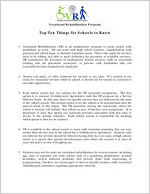Vocational Rehabilitation Program
Top Ten Things for Schools to Know
1. Vocational Rehabilitation (VR) is an employment program to assist people with disabilities to work. VR can work with high school students, supplemented with parental and school input, to identify transition needs. Those who apply for services need to be willing and able to work (following the provision of available services). VR coordinates the provision of employment related services, such as vocational training and job placement assistance, to persons with disabilities who can eventually become competitively employed.
2. Anyone can apply, or refer, someone for services at any time. If a student is not ready for vocational services while in school, it should not be viewed as a missed or one-time opportunity.
3. Each school system has two options for the VR counselor assignment. The first option is to contract (Collaborative Agreement) with the VR program for a Service Delivery Team. In this case, there are specific services that are delivered by the team to the school system. The second option is for the school to be incorporated into the general needs of the region. The VR counselor serving the community where the school is located will include that school as part of his/her total assignment. It is important to note that option two naturally provides counselors with less time to devote to the specific school(s). Each school system is responsible for deciding which option is best for its students.
4. VR is available to the school system to assist with transition planning; this can start earlier than the last year if the school has a Collaborative Agreement. Students who are referred for services should be referred during their last two years of high school, unless it is agreed that special circumstances exist where the student is at least 16 years old and is at risk of dropping out.
5. Students may not be ready for vocational rehabilitation for several reasons, including age, date of expected exit from school, lack of a qualifying impairment, medical instability, and/or behavior problems that prevent them from cooperating in programming. Teachers are encouraged to discuss specific students with vocational rehabilitation counselors regarding appropriate referrals.
Vocational Rehabilitation Program
Top Ten Things for Schools to Know
6. Every referral does not necessarily lead to an application for VR services. Opening a case is dependent upon student and/or parental choice.
7. Because VR policy requires quality individualized services, an assortment of assessments, evaluations, and documentation may be necessary. Although the progression of a case is expected to be timely, it should not be assumed that referral today means services tomorrow.
8. If a student is not ready for VR services, he/she can be referred at a later date. If a student is determined ineligible, application for services may be made again, should there be a change in circumstances. If a student's case is closed by VR for any reason, he/she can reapply to get a new case opened; however, some closures may require a 6-month waiting period before reopening.
9. Although Vocational Rehabilitation does provide a variety of services, they should not be described to students or parents as things "VR will do" for them. Each individual is assessed to determine individual needs; no two cases are alike. VR may pay for a service for one student, but not for another. Services are provided based on need, client choice, individual circumstances, available funds, and desired outcome. Services are funded based on the unique needs and economic circumstances of the individual, availability of funds and VR policies. VR assesses an individual's eligibility for specific services; there is no automatic entitlement to specific services.
10. Vocational Rehabilitation uses a "team" approach to provide comprehensive services to students. Each counselor is part of a team of VR staff.
